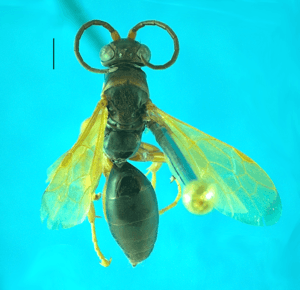Epipompilus insularis facts for kids
Quick facts for kids Epipompilus insularis |
|
|---|---|
 |
|
| Scientific classification |
The Epipompilus insularis is a special kind of spider wasp that lives only in New Zealand. It's the only wasp from the Epipompilus group that you'll find there! These wasps are fascinating hunters, especially known for how they deal with spiders.
What Does This Wasp Look Like?
This spider wasp is quite small. It's mostly black with wings that have a yellowish tint and dark tips. Female wasps are bigger, usually about 6.0 to 8.8 millimeters long. Males are smaller, around 3.5 to 5.6 millimeters.
Female wasps often have a bright orange-red band on their back, near their head (this part is called the pronotum). Interestingly, if you find a female wasp further south in New Zealand, this orange band gets smaller and smaller. Sometimes, it's barely there! Other colorful parts on the female, like the bases of her antennae, also become less colorful the further south she lives. This change in color based on location is a cool example of how animals adapt to their environment. Male wasps, however, don't change much in color.
How Does This Wasp Live?
E. insularis females are expert hunters. They usually search for spiders when the sun is shining brightly. They look for spiders that hide in secret spots, like inside rolled-up dead leaves, hollow plant stems, or even old cocoons left by other insects. They might also check under loose bark on trees.
When a female wasp finds a spider, she quickly runs towards it. As the spider lifts its legs to defend itself, the wasp stings it. Right after stinging, she lays a single egg on the spider and then moves away. The sting doesn't completely paralyze the spider, so it often recovers and starts moving again.
The wasp doesn't build a nest for its egg. Instead, the spider, with the wasp egg on it, usually stays in or near its hiding spot. Sometimes, the spider even spins a new hiding place after being stung. The young wasp larva (the baby wasp that hatches from the egg) is quite tough and can handle the spider moving around. If the spider was carrying its own eggs, the wasp larva might eat those eggs first, and then it will eat the spider itself as it grows.
Some of the spiders that E. insularis wasps hunt include those from the Trite and Clubiona groups.

